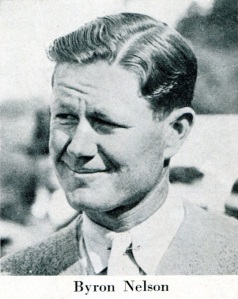“Did You Know”
Only six golf professionals made expenses on the 1938 Winter Tour!
The 1938 PGA Winter Tour began with tournaments in Florida and the Bahamas in late December 1937. From there the Tour leap froged the country to the west coast, then back through Texas to Florida again, and from there up the eastern seaboard to North Carolina. Now at its last stop, the Winter Tour was in Augusta, Georgia for the fifth running of the Masters Tournament.

While meeting with the golf writers at Augusta, PGA Tour Manager Fred Corcoran stated that only six golf professionals had won enough money to cover their expenses that winter. Corcoran said that Byron Nelson had started out on December 1 with $1,500 in travelers’ checks thinking he would play as long as that lasted. As of the end of March, Nelson had spent $2,000, winning $2,280 and he was not known to toss any money away. The leading money winner was Johnny Revolta, with $4,390.83. Seventy-five players had lost money, with 20 having borrowed money from Corcoran in order to keep playing. The average professional spent $75 a week. Augusta was an exception for those who had an invite. There was no entry fee, and the players were housed at the swanky Bon-Air hotel with breakfast and dinner for only $5 a day. Still the total purse was only $4,950.
There were a few lucrative tournaments like Miami’s $10,000 and Los Angeles’ $8,000, but most were less than $5,000, and many were only $3,000. Corcoran said that he had to twist the arm of the Bahamas tournament sponsor to boost the prize money up to $3,500. He said the operator of the boat that transported the professionals to the island made out better than they did. Corcoran calculated that prize money on the 17-event winter tour totaled $85,000 and the professionals had spent about $160,000 playing the tour. Tommy Armour said that if he was the commissioner of the PGA Tour, the minimum purse would be $25,000.
Corcoran was in his second year as the manager of the PGA Tour. Before Corcoran, Bob Harlow held the position. Harlow was more of a publicity man than promoter. He was a newspaper man who switched over to managing Walter Hagen’s exhibition tours until the Great Depression slowed all businesses. In late 1933 the PGA hired Harlow to organize and manage its fledging tour that followed the sun back and forth across the country. Harlow, whose pay was said to be meager, was writing a weekly newspaper article and managing some of the professionals on the side. In late 1936 he was fired by PGA President George Jacobus, who felt that Harlow was not giving his full attention to his position with the PGA. The professionals liked Harlow and complained to the PGA when he was relieved of his duties. From there Harlow moved to Pinehurst, North Carolina to be a publicity man for the Pinehurst resort. In 1947 he founded, Golf World, a weekly golf magazine that had a very successful 67-year run.
Corcoran was a born promoter. Nearly every day of the week the PGA Tour and its playing professionals were mentioned in the newspapers. In an interview at Augusta, Corcoran stated there would be an increase in the 1939 purses. He said that he was receiving many requests to hold PGA Tour tournaments. To be assured of a date on the PGA Tour schedule, a sponsor would have to put up at least $5,000. He said that he was going to schedule the tournaments nearer each other geographically to save on travel expenses. Corcoran cited Harry Cooper, the leading money winner in 1937, who put 40,000 miles on his automobile and spent $10,000 to win $14,138.
Because he managed some professionals like Sam Snead on the side he was thought to show favoritism. More than once he was punched in the nose by a player. Corcoran was fired and rehired several times by the PGA, but he was the best man for the job, lasting until 1948. It was Corcoran who saw the benefit of connecting the tournaments to a charity. Local businesses got on board and individuals gave their time to help manage the event. During World War II Corcoran managed charity golf events for the Red Cross. Later he helped found the LPGA. He managed golf events and golf tours along with the financial affairs of many professional athletes. Corcoran escorted professional golfers to 48 countries.
After the Masters, which Henry Picard won, the professionals all headed off to their club professional positions where they were assured a reliable remuneration. Picard was at Hershey CC, Nelson at Reading CC, and Snead the Greenbrier along with Cooper in Massachusetts and Revolta in Chicago.
It would not be until the early 1950s that golf professionals could make a living playing the PGA Tour. Then televised sports arrived in the 1960s and everything changed.

Leave a comment